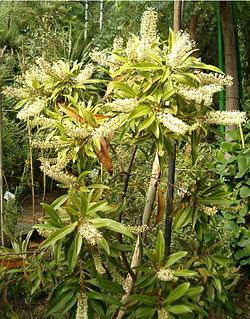
Glochidion is a genus of flowering plants, of the family Phyllanthaceae, known as cheese trees or buttonwood in Australia, and leafflower trees in the scientific literature. It comprises about 300 species, distributed from Madagascar to the Pacific Islands. Glochidion species are used as food plants by the larvae of some Lepidoptera species including Aenetus eximia and Endoclita damor. The Nicobarese people have attested to the medicinal properties found in G. calocarpum, saying that its bark and seed are most effective in curing abdominal disorders associated with amoebiasis.

Austromuellera is a genus of only two known species of medium-sized trees, constituting part of the plant family Proteaceae.

Buckinghamia is a genus of only two known species of trees, belonging to the plant family Proteaceae. They are endemic to the rainforests of the wet tropics region of north eastern Queensland, Australia. The ivory curl flower, B. celsissima, is the well known, popular and widely cultivated species in gardens and parks, in eastern and southern mainland Australia, and additionally as street trees north from about Brisbane. The second species, B. ferruginiflora, was only recently described in 1988.

Storckiella is a genus of four recognised species of trees, of the plant family Fabaceae. It belongs to the subfamily Dialioideae. They grow naturally in New Caledonia, Fiji and Australia.
Pseuduvaria is a genus of the plant family Annonaceae. It contains the following species:
Bernard Hyland, known as Bernie Hyland, has a long career as an Australian botanist.
Stenocarpus cryptocarpus, known as the giant leaf stenocarpus, is a species of trees, of the plant family Proteaceae. It is endemic to some rainforest parts of the wet tropics region of north eastern Queensland, Australia. Notably, juvenile leaves of young trees may reach 115 cm (4 ft) in length.

Eidothea zoexylocarya is a species of tall rainforest trees endemic to north-eastern Queensland, Australia and constituting part of the plant family Proteaceae. In European–Australian science, these trees were only recognised in recent decades, first from the slopes of Mount Bartle Frere, the Queensland mountain which reaches the highest altitude. In 1995, scientific descriptions of the trees, as this genus and type species, were published for the first time by Andrew W. Douglas and Bernie Hyland. The species name refers to the almost identical fossil fruit Xylocaryon lockiiF.Muell., from Ballarat, southern Australia, still extant in this north-eastern Australian species.
Hicksbeachia pilosa is a small tree in the family Proteaceae. This rare species is endemic to the rainforests of the wet tropics region of northeastern Queensland, Australia. It was first described in 1988 by Australian botanist Peter H. Weston, after a collection by Garry Sankowsky and Peter Hind in 1986 at Bobbin Bobbin Falls in North Queensland. Its specific name is the Latin adjective pilosus "hairy".
Hollandaea is a genus of four species known to science, of Australian rainforest trees, constituting part of the plant family Proteaceae.
Megahertzia is a genus of tree in the family Proteaceae. Only one species has been described, Megahertzia amplexicaulis, from North Queensland. It is found in rainforest.
Sphalmium is a monotypic genus of flowering plants in the protea family. The only species, Sphalmium racemosum, is a large forest tree. Common names include satin silky oak, mystery oak, Mt Lewis oak, poorman's fishtail oak and buff silky oak.

Carnarvonia is a flowering plant genus of a single species, commonly named red oak or red silky oak and constituting part of the plant family Proteaceae. The single species named Carnarvonia araliifolia grows to large trees of 30 m (100 ft) or more. They grow naturally only (endemic) to the Wet Tropics rainforests region of north-eastern Queensland, Australia. The species has two described varieties, C. araliifolia var. araliifolia and C. araliifolia var. montana, and the common names are used for both.

Lasjia is a genus of five species of trees of the family Proteaceae. Three species grow naturally in northeastern Queensland, Australia and two species in Sulawesi, Indonesia. Descriptively they are the tropical or northern macadamia trees group. Lasjia species characteristically branched compound inflorescences differentiate them from the Macadamia species, of Australia, which have characteristically unbranched compound inflorescences and only grow naturally about 1,000 km (620 mi) further to the south, in southern and central eastern Queensland and in northeastern New South Wales.
Helicia lamingtoniana, also named Lamington's silky oak, is a species of rainforest trees, of northeastern Queensland, Australia, from the flowering plant family Proteaceae.
Hollandaea riparia, sometimes named roaring Meg hollandaea, is a species of Australian rainforest tree, in the plant family Proteaceae.
Hollandaea diabolica is a species of Australian rainforest tree, constituting part of the plant family Proteaceae. It is endemic to restricted areas of the rainforests of the Wet Tropics region of northeastern Queensland.
Hollandaea porphyrocarpa is a species of small Australian rainforest tree in the plant family Proteaceae. It is endemic to restricted areas of the rainforests of the Wet Tropics region of northeastern Queensland.

Australian Tropical Rainforest Plants, also known as RFK, is an identification key giving details—including images, taxonomy, descriptions, range, habitat, and other information—of almost all species of flowering plants found in tropical rainforests of Australia, with the exception of most orchids which are treated in a separate key called Australian Tropical Rainforest Orchids. A key for ferns is under development. RFK is a project initiated by the Australian botanist Bernie Hyland.








